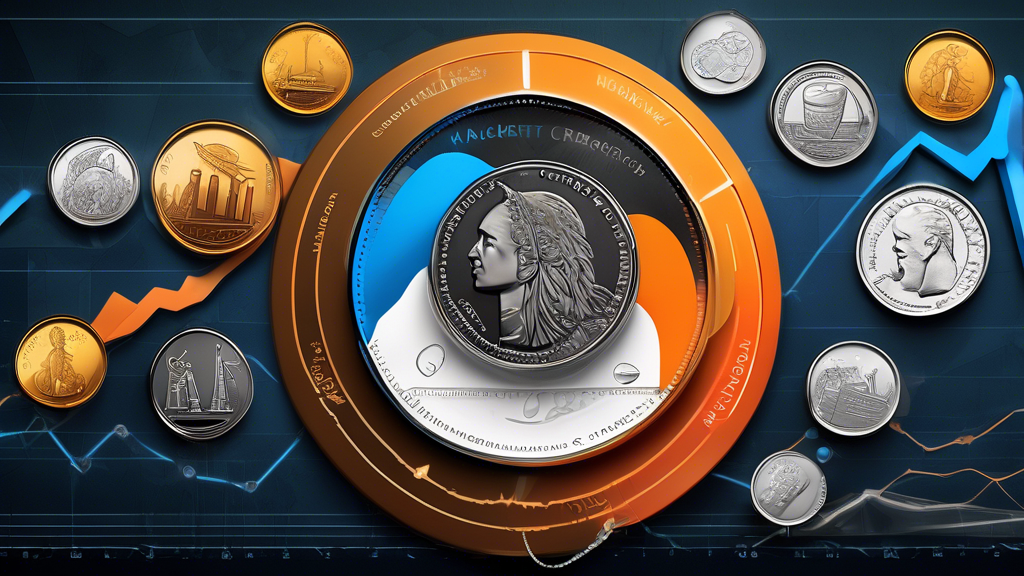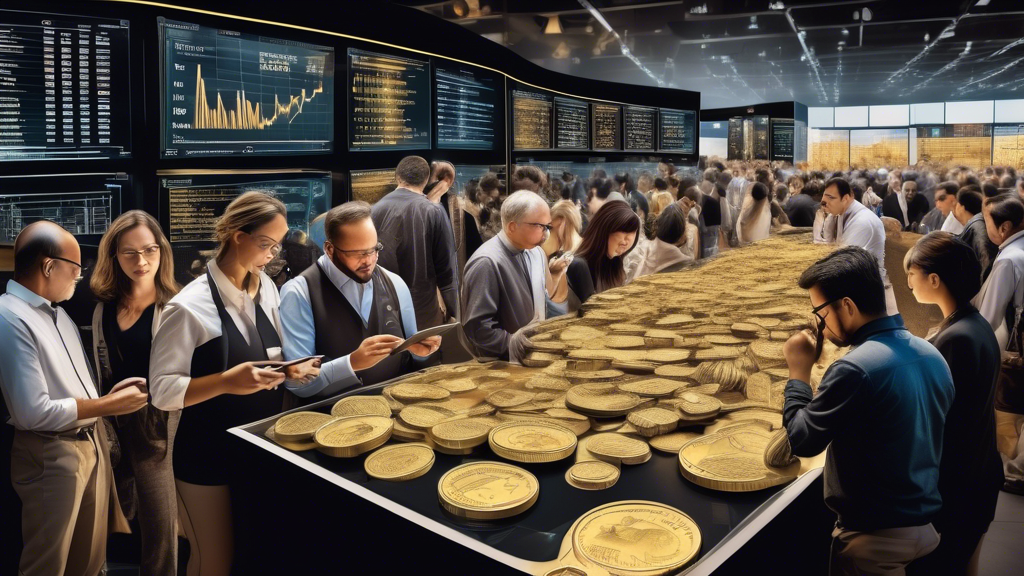Understanding the Trends in the Coins Market
The coins market has long been a cornerstone of economic history, capturing the attention of collectors, investors, and historians alike. As this market continues to evolve, understanding its intricate trends becomes crucial for anyone looking to navigate its complexities. From examining its historical performance to identifying current influences and predicting future trends, this article delves deep into the dynamics that drive the coins market.
Historical Performance and Growth in the Coins Market
The historical journey of the coins market reveals a tapestry of fascinating milestones and transformative events. Understanding this evolution provides valuable context for its current state and future trajectory. Over the decades, the market has been shaped by a confluence of economic, cultural, and technological influences, each leaving an indelible mark on its growth and development.
Current Influences Shaping the Coins Market
Today, the coins market is influenced by a myriad of factors, from global economic conditions to technological innovations. The rise of digital and cryptocurrency has introduced new dimensions to the traditional coins market, creating both opportunities and challenges. By analyzing these trends, stakeholders can gain a clearer view of the market’s present dynamics.
Future Predictions and Emerging Trends in the Coins Market
Looking ahead, the coins market is poised for further evolution. Expert predictions and emerging trends offer a glimpse into its potential future, guiding investors on how to strategically navigate forthcoming changes. Understanding these insights is essential for anyone aiming to stay ahead in the ever-changing landscape of the coins market.
Historical Performance and Growth in the Coins Market
Overview of the Historical Evolution of the Coins Market
The coins market has a rich history that spans centuries, evolving concurrently with the economic developments of various civilizations. Originally, coins were introduced as a convenient medium of exchange, eliminating the complexities of barter trade. The ancient Lydians are credited with creating the first standardized coins around 600 BCE, marking a pivotal moment in economic history. From the Roman dinarius to the Byzantine solidus, coins not only facilitated trade but also symbolized the sovereignty and economic prowess of empires.
Over time, the intrinsic and extrinsic values of coins started to diverge. In the Middle Ages, the shift from commodity money (coins made of precious metals) to representative money was significant. This transition laid the groundwork for modern banking and financial systems. The Renaissance period saw a surge in the collection of coins, known as numismatics, which today remains a popular hobby and investment strategy.
Key Milestones and Transformative Events
The coins market has witnessed several key milestones and transformative events that have shaped its trajectory. One of the earliest significant events was the introduction of coin minting technology by the Greeks, which standardized coinage and improved trade efficiency. The discovery of vast silver deposits in the New World during the 16th century flooded the European markets, leading to inflation but also to an expansion of the global trade network.
The Industrial Revolution brought about technological advancements that revolutionized coin production. The steam-powered coin press, invented in the 1790s, allowed for the mass production of coins, reducing costs and increasing the precision of coinage. This period also saw the emergence of central banks, which took over the responsibility of minting coins, ensuring standardization and stability.
In the 20th century, the Gold Standard played a crucial role in the global economy, tying the value of currencies to specific quantities of gold. However, the collapse of the Gold Standard in the 1970s led to fiat currency systems where coin value was no longer pegged to precious metals but was determined by government decree.
Market Growth Trends and Influences Over Time
The growth of the coins market has been influenced by various factors over time. Initially, the value of coins was directly correlated to the intrinsic value of the metals they were made from. However, as fiat currency systems took hold, the numismatic value—collectors’ interest based on rarity, historical significance, and condition—became a major driver in the market.
Throughout the 19th and 20th centuries, the market experienced steady growth, driven by an increasing interest in coin collecting and the establishment of professional numismatic organizations. The advent of the internet in the late 20th century further transformed the coins market, making it more accessible to a global audience. Online auctions and digital marketplaces like eBay enabled enthusiasts and investors to trade coins with unprecedented ease and transparency.
Economic downturns and geopolitical events have also significantly impacted the coins market. For instance, during periods of economic instability, investors often turn to precious metals like gold and silver, driving up the prices of coins made from these materials. Conversely, when economies stabilize, the speculative demand may wane, affecting market prices.
More recently, the market has seen a renewed interest in coin collecting, driven by a combination of historical fascination, investment potential, and technological innovation. Rare coin auctions have reported record-breaking sales, reflecting the high demand for unique and historically significant pieces. Moreover, the increasing influence of digital technologies and the rise of cryptocurrency have introduced new dynamics, further expanding the coins market.
In conclusion, the historical performance and growth of the coins market highlight the interplay between economic developments, technological advancements, and cultural interests. As we delve deeper into the current influences shaping the market and future predictions, it becomes evident that this market, with its rich heritage, continues to evolve, adapting to the changing landscape of global finance.
Current Influences Shaping the Coins Market
Impact of Economic Factors and Global Events
Economic factors and global events have a significant influence on the coins market. Currency fluctuations, inflation rates, and geopolitical stability are some of the key economic variables that impact coin values. For instance, during periods of economic instability, investors often seek refuge in tangible assets like coins, which historically maintain their value better than volatile stocks or currencies.
The global COVID-19 pandemic, for example, led to a surge in demand for precious metals, including rare coins. Investors flocked to the coins market, seeing it as a safe bet amidst the uncertainty. Similarly, changes in government policies, trade agreements, and international relations can also affect coin prices and demand. A strong economy generally boosts the collectible coins market as people have more disposable income to invest in these assets.
Technological Advancements and Innovations
Technological advancements are reshaping the coins market in unprecedented ways. One of the most significant impacts is from advanced minting technologies that allow for greater precision, security, and artistry in coin production. Modern techniques such as laser etching and digital designing are making it possible to create intricate and high-quality coins, which appeals to collectors and investors alike.
In addition, technology has revolutionized how coins are bought, sold, and authenticated. Online marketplaces and auction platforms have made it easier for buyers and sellers to connect globally. Digital platforms such as eBay, Heritage Auctions, and specialized numismatic websites have widened the market, allowing even novice collectors to participate in trading coins. Furthermore, advancements in authentication technology, including blockchain and tamper-proof chip integration, are providing greater assurance of coin authenticity, which is crucial in a market fraught with counterfeits.
Role of Digital and Cryptocurrency in the Traditional Coins Market
The rise of digital currency and cryptocurrency is another pivotal influence on the coins market. While digital currencies like Bitcoin and Ethereum do not have a physical form, their popularity and acceptance are indirectly affecting the traditional coins market. Investors and collectors often draw comparisons between digital assets and physical coins regarding their value storage capabilities and hedging against inflation.
Interestingly, the concept of ‘tokenization’ in cryptocurrency has drawn some parallels with limited edition and rare coins. Tokens can represent a fractional ownership in physical assets, including rare coins. This intersection of digital currency and tangible assets is creating new opportunities for hybrid investment portfolios, blending traditional numismatics with modern digital innovation.
Moreover, some traditional mints and numismatic organizations are experimenting with creating NFTs (Non-Fungible Tokens) tied to physical coins. These digital representations offer a new dimension of collecting, blending the tangibility of coins with the liquidity and tradability of digital assets. As the digital and traditional coins markets continue to evolve, their synergies are likely to spur greater interest and participation from a diverse range of investors.
Future Predictions and Emerging Trends in the Coins Market
Expert Predictions for the Coins Market
The coins market has always been an area of interest for investors, historians, and collectors. As we look ahead, expert predictions suggest that the coins market will witness significant transformations driven by a blend of technological advancements, economic shifts, and evolving collector preferences. Analysts forecast that the market will likely see a rise in demand for high-quality, rare coins as investors seek tangible assets amidst economic uncertainties.
Numismatics experts predict the continuous growth of virtual coin trading platforms, facilitating broader access and more dynamic participation in the coins market. This transition to digital platforms is expected to enhance transparency, ease of transaction, and global reach, thus attracting a new generation of coin enthusiasts and investors. Additionally, as blockchain technology becomes more integrated into various sectors, its application in verifying and authenticating coin transactions will further solidify trust and integrity in the market.
Emerging Trends and Their Potential Impact
The future of the coins market seems poised for exciting developments driven by several emerging trends. One notable trend is the increasing interest in themed coin series that commemorate historical events, cultural landmarks, and significant anniversaries. Collectors are showing a growing inclination toward thematic collections, which not only hold sentimental value but are also seen as appreciating assets in the long term.
Another emerging trend influencing the coins market is the integration of augmented reality (AR) and virtual reality (VR) in coin exhibitions and auctions. These technologies offer immersive experiences, enabling enthusiasts to view and examine coins in a highly detailed manner from the comfort of their homes. This could revolutionize the way coins are displayed, studied, and sold, making the market more accessible and engaging for a global audience.
Moreover, sustainability is becoming a noteworthy trend in the coins market. Eco-conscious collectors and institutions are beginning to favor coins made from recycled or sustainably sourced materials. The environmental impact of mining and metal extraction processes is drawing attention, prompting mints and manufacturers to explore greener alternatives. This shift toward sustainability could redefine production standards in the coins market and appeal to a broader demographic concerned with environmental conservation.
Strategies for Investors to Navigate Future Market Trends
In light of these emerging trends and predictions, investors looking to navigate the future coins market must adopt strategic approaches to maximize their returns and mitigate risks. Firstly, diversification remains a key strategy. By diversifying their coin portfolios, investors can spread risk across different types of coins, including historical coins, themed series, and modern commemorative coins.
Staying informed about technological advancements is equally important. Investors should leverage online platforms and blockchain technology to partake in the growing digital coins market confidently. Understanding how these technologies impact authentication and transaction processes can provide a competitive edge. Engaging in online coin communities and forums can also offer valuable insights and networking opportunities.
Another strategy involves focusing on sustainability trends. Investors could consider adding eco-friendly coins to their portfolios, tapping into the rising demand for sustainably produced collectibles. This approach not only aligns with global sustainability goals but also positions investors to benefit from the increasing market value of such items.
Lastly, consulting with numismatic experts and staying updated with market analyses can help in making informed decisions. Expert insights can guide investors on which coins hold the most potential for growth and appreciation. Regularly participating in coins market events, both virtual and physical, can also offer firsthand experience and education about the current state and future direction of the market.
In conclusion, the coins market is on the cusp of transformative changes, influenced by technological, economic, and societal factors. By understanding expert predictions, recognizing emerging trends, and adopting strategic investment approaches, investors can effectively navigate the evolving landscape and capitalize on future opportunities in the coins market.
Conclusion
In conclusion, the coins market has undergone significant transformations from its historical roots to the present day, influenced by a myriad of factors ranging from economic conditions to technological advancements. Historical performance reveals a market that has continually evolved, with key milestones marking its growth and development over time. The impact of major global events and the integration of digital currencies have further reshaped the landscape, presenting both challenges and opportunities for investors and collectors alike.
The Persisting Influence of Tradition and Innovation
While traditional coins retain their intrinsic value and historical significance, the rise of digital and cryptocurrencies introduces a dynamic element to the coins market. Technological innovations have not only enhanced the way coins are traded and authenticated but have also broadened the scope for new forms of currency to emerge. This blend of tradition and modernity offers a unique vantage point for understanding the complexities of the current market.
Anticipating Future Movements
Looking forward, expert predictions suggest a continued interplay between traditional and digital currencies, with emerging trends poised to shape the future landscape. Factors such as increasing digital adoption, regulatory changes, and global economic shifts will be crucial in determining market trajectories. For investors, staying informed about these trends and adopting adaptable strategies will be essential for navigating the evolving coins market successfully.
Ultimately, the coins market remains a vibrant and multifaceted arena, where historical richness meets modern innovation. By understanding past influences and anticipating future directions, stakeholders can better position themselves to leverage opportunities and mitigate risks in this ever-changing market.



